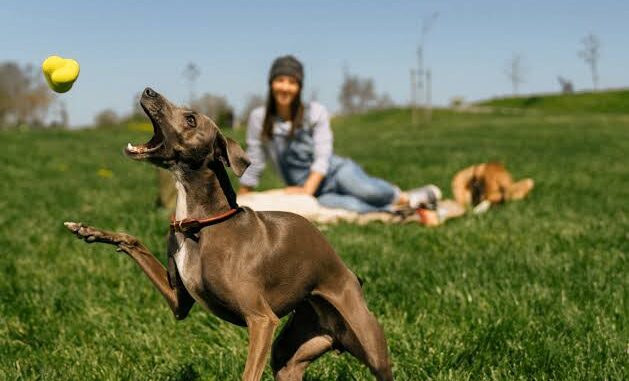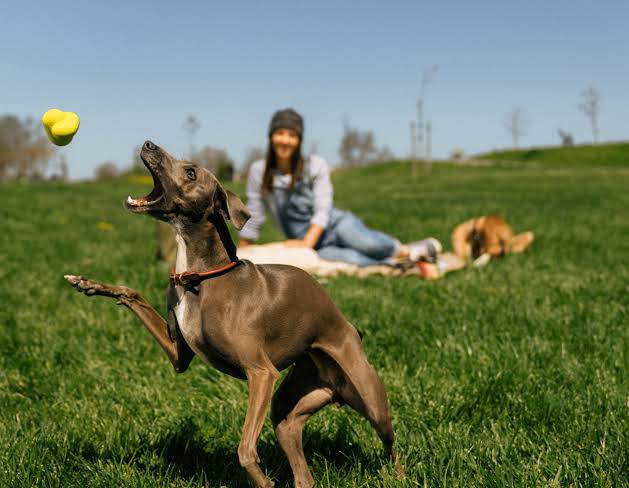
How to Teach Your Dog to Play Fetch: Playing fetch with your dog is more than just a fun activity it’s a perfect blend of exercise, mental stimulation, and bonding. Whether you have a playful puppy or a laid-back adult dog, fetch can become one of their favorite games if taught correctly.

While some dogs naturally chase and retrieve objects, many need to learn the steps. In this guide, we’ll cover why fetch is beneficial, step-by-step training methods, troubleshooting tips.
Why Teach Fetch?
Fetch is a useful command with multiple advantages:
- Physical Exercise: Especially for high-energy breeds.
- Mental Engagement: Chasing, locating, and returning a toy requires concentration.
- Obedience Reinforcement: Teaches commands like “drop it,” “come,” and “leave it.”
- Bonding Time: Reinforces your dog’s connection with you through play.
Whether you’re indoors with soft toys or outdoors with balls, fetch can be adapted to nearly every dog and setting.
Step-by-Step: How to Teach Your Dog to Play Fetch
Step 1: Choose the Right Toy
Not every dog likes tennis balls. Find what motivates your dog:
- Tennis balls or rubber balls for retrievers and active dogs
- Squeaky toys for sound-driven dogs
- Plush toys for soft-mouthed dogs or puppies
- Frisbees or discs for agile, athletic dogs
Let your dog pick the toy they seem most interested in.
Consistency matters. Use the same toy at first to avoid confusion.
Step 2: Build Toy Interest
Some dogs need encouragement to even care about the fetch object. Try:
- Playing tug with the toy
- Squeaking or tossing it short distances
- Smearing a little peanut butter on it (for flavor motivation)
Once they’re enthusiastic about the toy, you’re ready to move on.
Step 3: Teach the “Chase” Behavior
Start in a small, enclosed area—like a hallway or fenced yard. Sit with your dog and toss the toy a short distance.
- If they chase: Praise and encourage.
- If not: Move closer to the toy and excite them with vocal cues (“Get it!”).
Avoid overwhelming your dog—start small and build confidence.
Step 4: Encourage the Return
This is where many dogs get “stuck.” They may chase the toy but not bring it back. Try:
- Running backward to encourage pursuit
- Calling their name excitedly while crouching (a play-inviting posture)
- Using a second toy: Show them the second toy and toss it only after they bring back the first
Once they return, reward them instantly with treats or play.
Step 5: Teach the “Drop It” Command
When your dog returns with the toy, they may not want to release it. To teach “drop it”:
- Offer a treat while holding your hand under the toy
- Say “drop it” clearly and wait
- When they release, reward immediately
Repeat until they associate “drop it” with getting a treat or another round of fetch.
Never forcefully pull the toy from their mouth—it can create resistance and reduce trust.
Step 6: Combine the Behaviors
Once your dog understands each part—chasing, retrieving, and dropping—you can combine them into a seamless game:
- Say “fetch” or “get it” while tossing the toy.
- Call them back if they hesitate.
- Use “drop it” to release the toy.
- Praise and repeat.
Short, frequent sessions work better than long ones. Aim for 5–10 minutes twice a day.
READ ALSO: How to Keep Your Dog Active During the Winter Months
Troubleshooting Common Problems
My dog chases the toy but won’t bring it back.
Use a long leash or training lead to gently guide them back. Also, try throwing the toy in a hallway where there’s only one return path toward you.
My dog grabs the toy and runs away.
This is often a control or attention-seeking behavior. Don’t chase them. Instead:
- Turn away and ignore them.
- Wait until they come to you.
- Use two identical toys and only throw the second when they come back.
My dog fetches a few times, then loses interest.
Keep sessions short and rewarding. Mix in treats, affection, or a new toy mid-session. If your dog gets bored, it may not be physically or mentally challenging enough.
My dog won’t give up the toy.
Work more on the “drop it” command outside of fetch. Make it a game: offer a treat, ask for the drop, and give the toy right back. Build trust that they’re not “losing” the toy forever.
My dog isn’t food-motivated.
Use toys or praise instead of treats. Some dogs prefer a good tug session or verbal encouragement over snacks.
Special Tips by Age and Breed
Puppies
- Use soft, lightweight toys.
- Focus on building interest and chasing.
- Keep sessions extremely short (2–3 minutes).
- Avoid high-impact throws until growth plates are closed (around 12–18 months).
Adult Dogs
- Great for learning fetch as their focus is more developed.
- Mix fetch with other commands for mental stimulation.
Seniors
- Go slow. Use soft toys and short throws.
- Make it a bonding experience rather than a workout.
By Breed
- Retrievers, Border Collies, Australian Shepherds: Natural fetchers—just refine the “drop it” command.
- Sighthounds (Greyhounds, Whippets): May chase but not return. Work on recall and motivation.
- Brachycephalic breeds (Pugs, Bulldogs): Use caution—monitor breathing and avoid overheating.
- Toy breeds: Use light, soft toys and reward heavily for each success.
Advanced Fetch Variations
Once your dog masters basic fetch, consider upping the game:
- Water Fetch: For dogs that love swimming (like Labs)
- Frisbee Catch: Great for agile dogs with good coordination
- Hide-and-Fetch: Toss a toy behind obstacles to trigger scent-tracking
- Fetch with Commands: Combine sit, stay, or down before throws
Training Tools That Help
- Clicker: For precise marking of good behavior
- Long leash: Helps with return training
- Ball launcher: For high-energy breeds needing longer throws
- Treat pouch: Makes reward timing easier
FAQs
At what age can I start teaching fetch?
As early as 8 weeks! Keep it gentle and focus on fun and chasing, not perfect obedience.
My dog doesn’t care about toys. Can I still teach fetch?
Yes, try toys with food scent, squeakers, or movement. Pair toys with treats to create a positive association.
Can I teach an older dog to fetch?
Absolutely. Senior dogs can learn fetch, but adjust the pace and intensity. Use soft, slow throws and build gradually.
How long does it take to teach fetch?
It varies. Some dogs learn in a day, others take weeks. Consistency, motivation, and breaking it into steps are key.
My dog fetches but won’t drop the toy. What do I do?
Work on “drop it” separately with high-value rewards. Only play fetch when they reliably release the toy.
Is fetch safe for all dogs?
Generally yes, but monitor for signs of overheating, especially in hot weather or with short-nosed breeds. Avoid fetch near roads or steep terrain.
Can I play fetch indoors?
Definitely! Use soft toys in a hallway or large room. Great for rainy days or winter.
Leave a Reply
You must be logged in to post a comment.